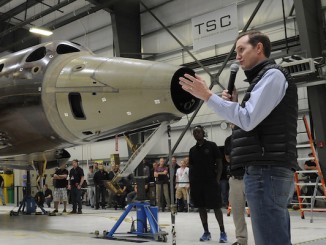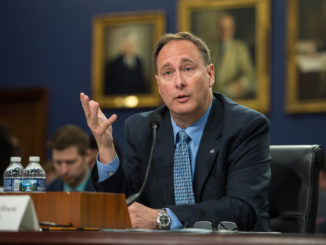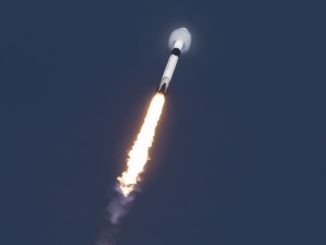
Two months after a first test-firing ended prematurely, NASA plans to ignite the core stage of the first Space Launch System heavy-lift rocket again Thursday for an eight-minute burn to confirm it is ready for shipment to the Kennedy Space Center for launch preparations.
The critical hot fire test is planned during a two-hour window beginning at 3 p.m. EDT (2 p.m. CDT; 1900 GMT) on the B-2 test stand at NASA’s Stennis Space Center in southern Mississippi.
If all goes according to plan, the rocket’s four liquid-fueled Aerojet Rocketdyne RS-25 engines will fire for about eight minutes, the same time they will fire when the Space Launch System blasts off from the Kennedy Space Center.
Once the test-firing is complete, ground crews will inspect the Boeing-made core stage, remove it from its firing stand, and put it inside NASA’s Pegasus barge for shipment to the Florida launch site for attachment to the rocket’s two side-mounted solid rocket boosters, upper stage, and an Orion capsule the SLS will propel on a mission to the moon.
The fully-assembled rocket will stand about 322 feet, or 98 meters, tall. NASA completed stacking of the two 17-story Northrop Grumman-built solid rocket boosters earlier this month inside the Vehicle Assembly Building at Kennedy. The boosters will provide the bulk of the 8.8 million pounds of thrust the SLS will produce at full power, more than any U.S. rocket in history.
The oft-delayed Space Launch System is a centerpiece of NASA’s Artemis program, which aims to return astronauts to the moon. The SLS will launch Orion crew capsules with up to four astronauts on lunar expeditions, beginning with the second SLS flight.
The first SLS/Orion mission, named Artemis 1, will not carry astronauts. The core stage to be test-fired Thursday is the same rocket that will fly on Artemis 1.

NASA attempted an eight-minute test-firing of the SLS core stage Jan. 16, but the four RS-25 engines shut down a little more than a minute after ignition. Engineers traced the cause of the premature shutdown to a hydraulic system parameter that tripped an overly-conservative setting for the test, the last phase of a “Green Run” test and checkout campaign for the SLS core stage at Stennis.
The core stage hydraulics drive actuators that pivot, or gimbal, the four RS-25 engines to steer the rocket after liftoff.
Managers want to get at least four minutes of run time on the RS-25 engines on the second hot fire test to gather enough data to build confidence in the rocket’s performance before shipping the stage to the Kennedy Space Center. But ideally, the test will run the full planned duration of 485 seconds.
The four RS-25 engines on the first SLS core stage are leftovers from the space shuttle program. All flew on multiple shuttle launches, and engineers outfitted the engines with new computers and software to fly on the Space Launch System, plus thermal insulation to shield the RS-25s from the super-heated exhaust plume of the solid boosters.
Three of the main engines launched on each shuttle flight, but four RS-25 engines had never ignited together on the same rocket until the shortened Jan. 16 hot fire test. The four engines generate about 1.6 million pounds of thrust at sea level, operating at slightly higher throttle settings than during the shuttle era.
Here’s a replay of the first hotfire test of the Space Launch System core stage, which was cut short a little more than a minute into a planned eight-minute firing.
The rocket and engines safely shut down. NASA plans a post-test media briefing tonight.https://t.co/B639YAgQec pic.twitter.com/FXHuxAV7ok
— Spaceflight Now (@SpaceflightNow) January 16, 2021
Each RS-25 engine weighs about 7,800 pounds, or 3.5 metric tons. Unlike the space shuttle, the SLS core stage is disposable, and the engines won’t be reused.
NASA’s test team at Stennis will begin loading liquid hydrogen and liquid oxygen into the 212-foot-tall (65-meter) rocket early Thursday. The cryogenic propellants are stored at minus 423 degrees Fahrenheit and minus 297 degrees Fahrenheit (minus 253 and minus 183 Celsius).
Six propellant barges will be docked in the turning basin next to the B-2 test stand to feed more than 733,000 gallons of propellants into the rocket, enough to fill 63 large tanker trucks.
In addition to engine data, engineers will monitor how the rocket’s flight computers, avionics, and hydraulic systems function during the hot fire test. More than 500 sensors will collect information on temperatures, pressures, structural loads, and other parameters.
Assuming the core stage performs well Thursday, NASA hopes to have the rocket at Kennedy by the end of April.
NASA planned to attempt a second Green Run hot fire test last month, but managers delayed the engine firing to investigate a stuck liquid oxygen “prevalve” feeding propellant to one of the four RS-25 engines.
Engineers repaired the valve and announced earlier this month that preparations for the second Green Run hot fire test had resumed.
The Green Run hot fire test has been delayed more than six months since the SLS core stage arrived at Stennis in January 2020. A temporary suspension of work caused by the COVID-19 pandemic initially delayed preparations for the test, and a series of hurricanes and tropical storms that impacted the Gulf Coast last year also slowed work at the Stennis Space Center.

NASA was tasked by the Trump administration with landing a crew near the south pole of the moon by the end of 2024. The Biden administration has expressed support for the Artemis program, but has not set a timetable for a crewed lunar landing mission.
The 2024 schedule goal was already slipping away before the end of the Trump administration. Congress approved only a fraction of the funding NASA requested in fiscal year 2021 for the Artemis program’s human-rated lunar lander development.
Kathy Lueders, head of NASA’s human spaceflight directorate, said last month the SLS Green Run delays were “very, very tough.”
“This is the one last piece that we have waiting for us to get down to the Cape for us to go fly,” Lueders said. She said NASA is still “hoping” to fly the first SLS rocket at the end of this year.
But it is more likely that the Artemis 1 test launch will not happen until early 2022. The Artemis 2 mission is scheduled to carry four astronauts around the moon in 2023, and NASA plans to launch the first elements of a mini-space station named the Gateway in 2024.
Email the author.
Follow Stephen Clark on Twitter: @StephenClark1.



